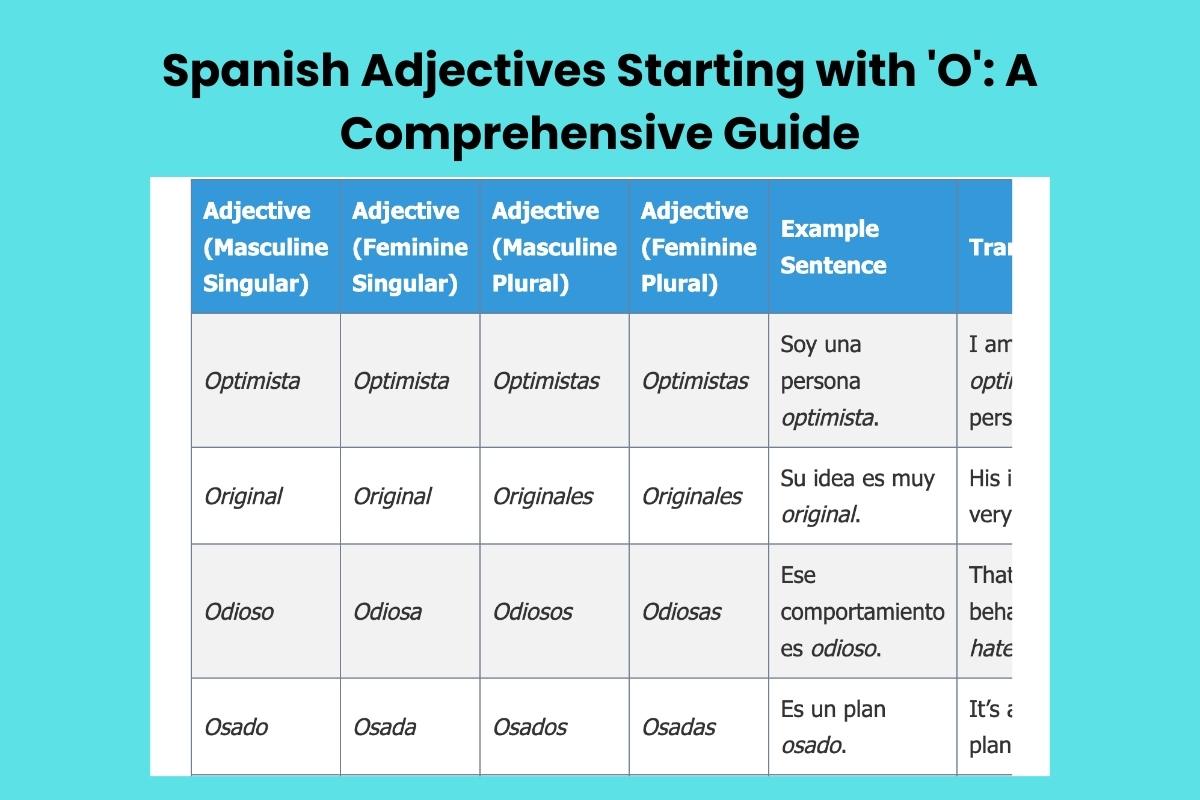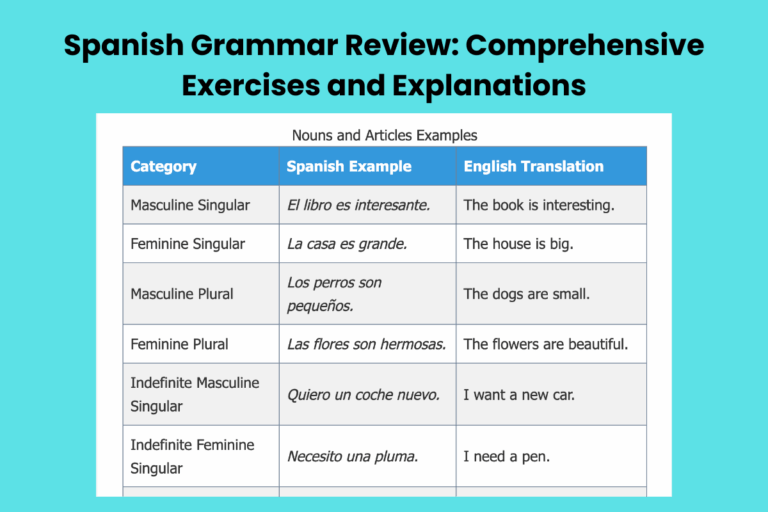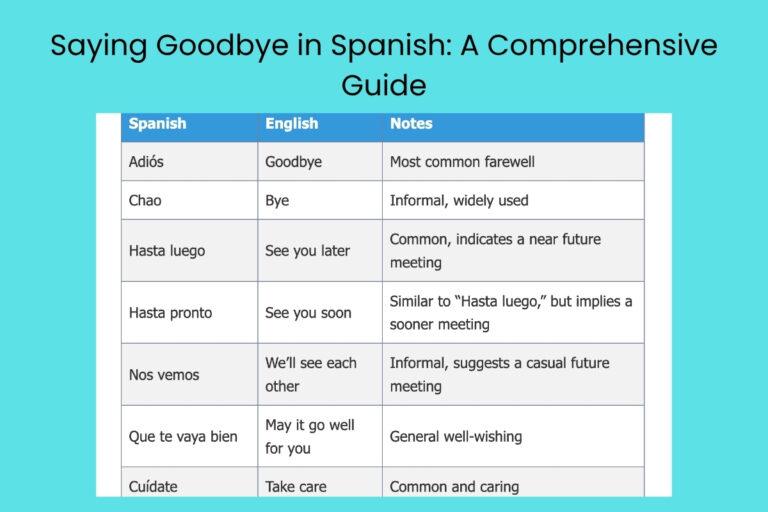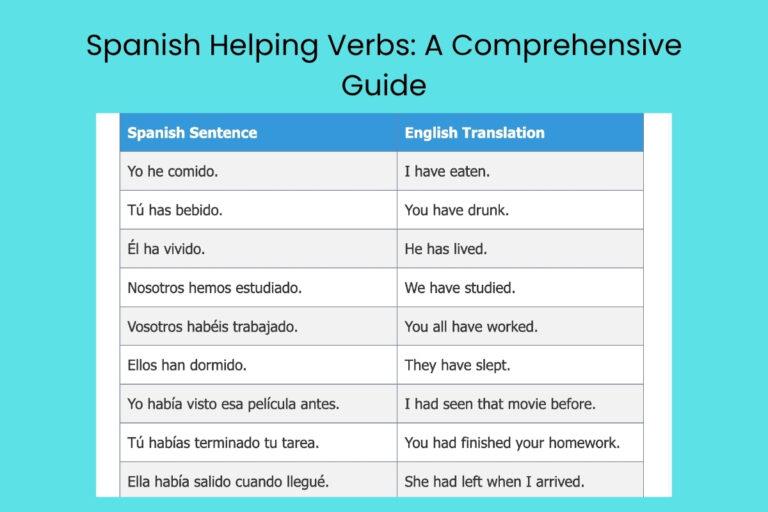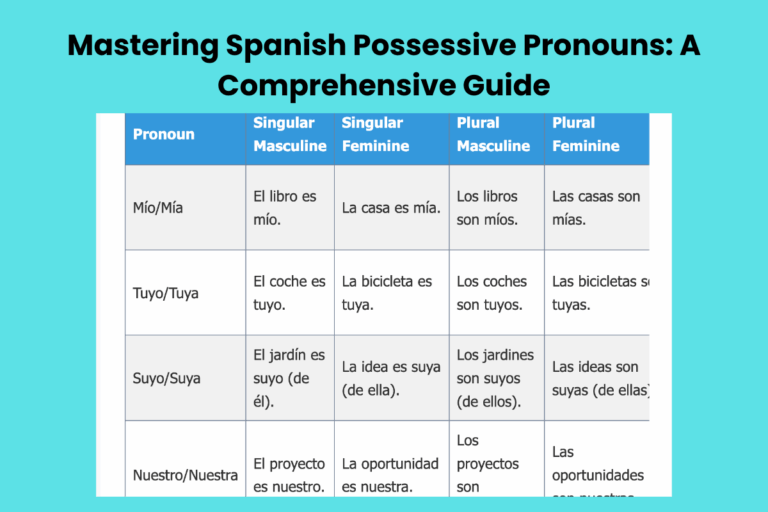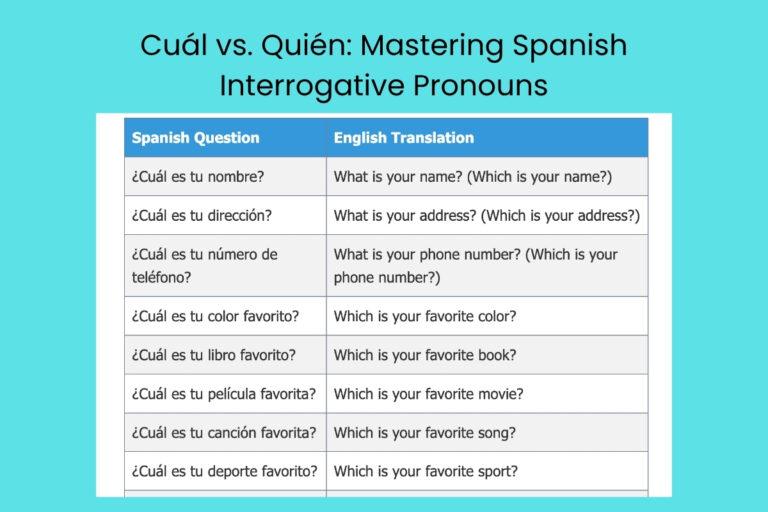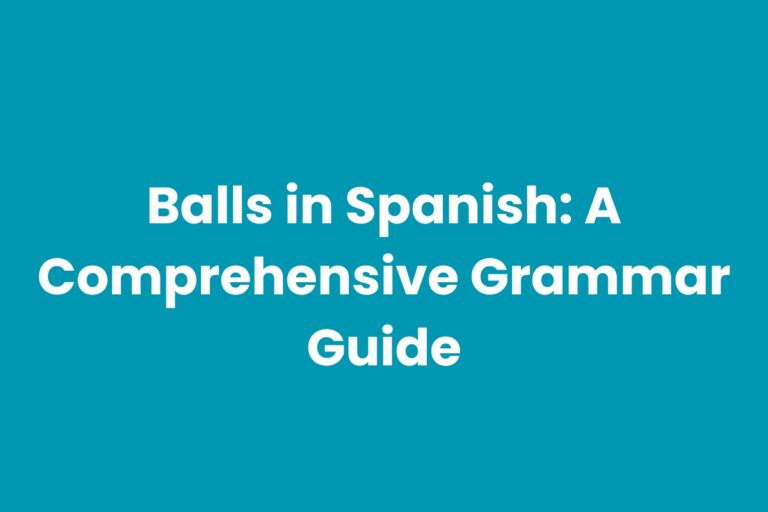Spanish Adjectives Starting with ‘O’: A Comprehensive Guide
Understanding Spanish adjectives is crucial for describing nouns accurately and adding detail to your sentences. This article focuses specifically on Spanish adjectives that begin with the letter ‘O’, providing a comprehensive overview of their meanings, usage, and grammatical considerations.
Mastering these adjectives will significantly enhance your ability to express yourself in Spanish, allowing for richer and more nuanced communication. This guide is designed for learners of all levels, from beginners seeking to expand their vocabulary to advanced students aiming to refine their grammar skills.
Table of Contents
- Introduction
- Definition of Spanish Adjectives Starting with ‘O’
- Structural Breakdown
- Types and Categories of ‘O’ Adjectives
- Examples of Spanish Adjectives Starting with ‘O’
- Usage Rules for Spanish Adjectives Starting with ‘O’
- Common Mistakes with Spanish Adjectives Starting with ‘O’
- Practice Exercises
- Advanced Topics
- Frequently Asked Questions (FAQ)
- Conclusion
Definition of Spanish Adjectives Starting with ‘O’
In Spanish grammar, adjectives are words that modify nouns, providing more information about their qualities or characteristics. Adjectives that start with the letter ‘O’ function identically to other adjectives but are distinguished by their initial letter.
These adjectives, like all Spanish adjectives, must agree in gender (masculine or feminine) and number (singular or plural) with the nouns they modify. This agreement is a fundamental aspect of Spanish grammar and essential for constructing grammatically correct sentences.
The primary function of an adjective is to describe. Adjectives starting with ‘O’ can describe a wide range of attributes, from physical characteristics and qualities to origins and states of being.
Understanding the specific meaning and usage of each adjective is crucial for effective communication. They enhance descriptions, making them more vivid and precise.
They play a vital role in conveying emotions, opinions, and subjective assessments.
The context in which an adjective is used often influences its specific meaning or connotation. For example, the adjective “original” can describe something as being novel or unique, or it can refer to the source or origin of something. The ability to discern the appropriate meaning based on context is a key aspect of mastering Spanish vocabulary. Recognizing the subtleties of language enriches communication and comprehension.
Structural Breakdown
Spanish adjectives, including those starting with ‘O’, follow specific structural rules. The most important rule is agreement with the noun. This means that the adjective must match the noun in both gender and number. Masculine nouns generally take the -o ending, while feminine nouns take the -a ending. Plural forms are typically created by adding -s or -es, depending on the ending of the singular form.
Consider the adjective “orgulloso” (proud). If you want to describe a proud man, you would use “hombre orgulloso.” However, if you are describing a proud woman, you would use “mujer orgullosa.” For plural nouns, you would use “hombres orgullosos” and “mujeres orgullosas.” This pattern applies to most adjectives ending in -o, but there are exceptions, particularly with adjectives that don’t end in -o or -a in their base form.
Some adjectives are invariable, meaning they do not change form based on gender. However, they still need to agree in number.
These are less common among adjectives that start with ‘O’. Adjectives often follow the noun they modify, especially in descriptive contexts.
However, some adjectives precede the noun, particularly those expressing subjective qualities or inherent characteristics. The placement of adjectives can also influence the emphasis or nuance of the sentence.
Types and Categories of ‘O’ Adjectives
Spanish adjectives starting with ‘O’ can be categorized based on their meaning and function. Here are some key categories:
Descriptive Adjectives
These adjectives describe physical characteristics, qualities, or attributes of a noun. They provide specific details that help to create a more vivid and detailed image.
Examples include: “oscuro” (dark), “obeso” (obese), “ovalado” (oval), “opaco” (opaque).
Qualitative Adjectives
Qualitative adjectives express subjective qualities or opinions about a noun. They reflect personal judgments or assessments.
Examples include: “optimista” (optimistic), “original” (original), “odioso” (hateful), “osado” (bold).
Relational Adjectives
Relational adjectives indicate a relationship or connection to a particular place, time, or thing. They often specify origin or belonging.
Examples include: “oriental” (eastern), “oceánico” (oceanic), “oficial” (official), “óptico” (optical).
Adjectives of Quantity
While less common with the letter ‘O’, some adjectives can express quantity or amount, even if indirectly.
Examples include: “óctuple” (octuple – though more often used as a noun or adverbial), “omnipresente” (omnipresent – implying a large quantity of presence).
Examples of Spanish Adjectives Starting with ‘O’
The following tables provide extensive examples of Spanish adjectives starting with ‘O’, categorized by their type and with example sentences to illustrate their usage.
Table 1: Descriptive Adjectives
This table focuses on descriptive adjectives starting with ‘O’, showcasing how they are used to describe different nouns in various contexts. Understanding these adjectives will help you paint a more detailed picture with your Spanish.
| Adjective (Masculine Singular) | Adjective (Feminine Singular) | Adjective (Masculine Plural) | Adjective (Feminine Plural) | Example Sentence | Translation |
|---|---|---|---|---|---|
| Oscuro | Oscura | Oscuros | Oscuras | El cuarto está muy oscuro. | The room is very dark. |
| Obeso | Obesa | Obesos | Obesas | El gato es un poco obeso. | The cat is a bit obese. |
| Ovalado | Ovalada | Ovalados | Ovaladas | La mesa tiene una forma ovalada. | The table has an oval shape. |
| Opaco | Opaca | Opacos | Opacas | El vidrio es opaco. | The glass is opaque. |
| Ocre | Ocre | Ocre | Ocre | La pared es de color ocre. | The wall is ochre colored. |
| Ondulado | Ondulada | Ondulados | Onduladas | Ella tiene el pelo ondulado. | She has wavy hair. |
| Oleoso | Oleosa | Oleosos | Oleosas | La piel de mi cara es oleosa. | The skin on my face is oily. |
| Ojeroso | Ojerosas | Ojerosos | Ojerosas | Después de la noche sin dormir, estaba ojeroso. | After the sleepless night, I was dark-circled. |
| Obstinado | Obstinada | Obstinados | Obstinadas | Él es un hombre obstinado. | He is an obstinate man. |
| Ostentoso | Ostentosa | Ostentosos | Ostentosas | Su boda fue muy ostentosa. | Their wedding was very ostentatious. |
| Oblicuo | Oblicua | Oblicuos | Oblicuas | La línea es oblicua. | The line is oblique. |
| Occidental | Occidental | Occidentales | Occidentales | La cultura occidental es muy diversa. | The western culture is very diverse. |
| Oculto | Oculta | Ocultos | Ocultas | El tesoro está oculto. | The treasure is hidden. |
| Ofendido | Ofendida | Ofendidos | Ofendidas | Él está ofendido por tus palabras. | He is offended by your words. |
| Original | Original | Originales | Originales | Esta es una pintura original. | This is an original painting. |
| Ordinario | Ordinaria | Ordinarios | Ordinarias | Es un día ordinario. | It’s an ordinary day. |
| Orgánico | Orgánica | Orgánicos | Orgánicas | Compro productos orgánicos. | I buy organic products. |
| Ornamental | Ornamental | Ornamentales | Ornamentales | Este jardín es ornamental. | This garden is ornamental. |
| Olvidadizo | Olvidadiza | Olvidadizos | Olvidadizas | Soy muy olvidadizo. | I am very forgetful. |
| Ocioso | Ociosa | Ociosos | Ociosas | No me gusta estar ocioso. | I don’t like to be idle. |
| Onírico | Onírica | Oníricos | Oníricas | Tuvo una experiencia onírica. | He had a dreamlike experience. |
| Operacional | Operacional | Operacionales | Operacionales | El sistema está operacional. | The system is operational. |
| Opinable | Opinable | Opinables | Opinables | Este tema es opinable. | This topic is debatable. |
Table 2: Qualitative Adjectives
This table focuses on qualitative adjectives, which are used to describe subjective qualities or opinions. Understanding these adjectives will help you express your thoughts and feelings more effectively in Spanish.
| Adjective (Masculine Singular) | Adjective (Feminine Singular) | Adjective (Masculine Plural) | Adjective (Feminine Plural) | Example Sentence | Translation |
|---|---|---|---|---|---|
| Optimista | Optimista | Optimistas | Optimistas | Soy una persona optimista. | I am an optimistic person. |
| Original | Original | Originales | Originales | Su idea es muy original. | His idea is very original. |
| Odioso | Odiosa | Odiosos | Odiosas | Ese comportamiento es odioso. | That behavior is hateful. |
| Osado | Osada | Osados | Osadas | Es un plan osado. | It’s a bold plan. |
| Orgulloso | Orgullosa | Orgullosos | Orgullosas | Estoy orgulloso de ti. | I am proud of you. |
| Obvio | Obvia | Obvios | Obvias | Es obvio que estás cansado. | It’s obvious that you are tired. |
| Notable | Notable | Notables | Notables | Es un talento notable. | It’s a remarkable talent. |
| Necesario | Necesaria | Necesarios | Necesarias | Es necesario estudiar. | It’s necessary to study. |
| Notable | Notable | Notables | Notables | Es un logro notable. | It’s a notable achievement. |
| Noble | Noble | Nobles | Nobles | Es una persona noble. | He is a noble person. |
| Oportuno | Oportuna | Oportunos | Oportunas | Es un momento oportuno. | It’s an opportune moment. |
| Ofensivo | Ofensiva | Ofensivos | Ofensivas | Ese comentario fue ofensivo. | That comment was offensive. |
| Pacífico | Pacífica | Pacíficos | Pacíficas | Es un lugar pacífico. | It is a peaceful place. |
| Perfecto | Perfecta | Perfectos | Perfectas | Es un día perfecto. | It’s a perfect day. |
| Peligroso | Peligrosa | Peligrosos | Peligrosas | Es un camino peligroso. | It’s a dangerous road. |
Table 3: Relational Adjectives
This table focuses on relational adjectives, which express relationships or connections. Understanding these adjectives will help you specify origins, affiliations, and connections in Spanish.
| Adjective (Masculine Singular) | Adjective (Feminine Singular) | Adjective (Masculine Plural) | Adjective (Feminine Plural) | Example Sentence | Translation |
|---|---|---|---|---|---|
| Oriental | Oriental | Orientales | Orientales | La cultura oriental es fascinante. | Eastern culture is fascinating. |
| Oceánico | Oceánica | Oceánicos | Oceánicas | El clima oceánico es húmedo. | The oceanic climate is humid. |
| Oficial | Oficial | Oficiales | Oficiales | Este documento es oficial. | This document is official. |
| Óptico | Óptica | Ópticos | Ópticas | Necesito una revisión óptica. | I need an optical check-up. |
| Ordinario | Ordinaria | Ordinarios | Ordinarias | El salario ordinario no es suficiente. | The ordinary salary is not enough. |
| Obrero | Obrera | Obreros | Obreras | La clase obrera es importante. | The working class is important. |
| Ocasional | Ocasional | Ocasionales | Ocasionales | Este trabajo es ocasional. | This job is occasional. |
| Obligatorio | Obligatoria | Obligatorios | Obligatorias | Este curso es obligatorio. | This course is mandatory. |
| Operativo | Operativa | Operativos | Operativas | El sistema está operativo. | The system is operational. |
Usage Rules for Spanish Adjectives Starting with ‘O’
Using Spanish adjectives correctly involves understanding several key rules:
- Agreement: As mentioned earlier, adjectives must agree in gender and number with the nouns they modify. This is the most fundamental rule.
- Placement: Adjectives typically follow the noun in Spanish, but some adjectives, especially those expressing inherent qualities or subjective opinions, often precede the noun.
- Exceptions: Some adjectives have shortened forms when they appear before masculine singular nouns. This is less common with ‘O’ adjectives.
- Compound Adjectives: Adjectives can be combined to create more complex descriptions.
For example, consider the adjective “optimista” (optimistic). You would say “una persona optimista” (an optimistic person). The adjective remains the same regardless of gender because it is invariable in gender. However, for a masculine noun, it would also be “un hombre optimista.”
Adjective placement can change the meaning or emphasis of a sentence. For example, “un gran hombre” (a great man) differs from “un hombre grande” (a big man).
The first implies the man is remarkable, while the second describes his physical size.
Common Mistakes with Spanish Adjectives Starting with ‘O’
Here are some common mistakes to avoid when using Spanish adjectives starting with ‘O’:
- Incorrect Agreement: Failing to match the gender and number of the adjective with the noun.
- Incorrect Placement: Placing the adjective in the wrong position, which can alter the meaning of the sentence.
- Using the Wrong Form: Not using the correct masculine, feminine, singular, or plural form.
Example of Incorrect Agreement:
- Incorrect: “El libro es oscura.”
- Correct: “El libro es oscuro.” (The book is dark.)
Example of Incorrect Placement:
- Incorrect: “Un hombre grande.” (Intended meaning: A great man)
- Correct: “Un gran hombre.” (A great man)
Practice Exercises
Test your understanding of Spanish adjectives starting with ‘O’ with the following exercises. Fill in the blanks with the correct form of the adjective provided in parentheses.
Exercise 1: Adjective Agreement
Choose the correct form of the adjective from the options provided to complete each sentence.
| Question | Options | Answer |
|---|---|---|
| La noche es muy (oscuro / oscura). | oscuro / oscura | oscura |
| El gato es (obeso / obesa). | obeso / obesa | obeso |
| Las mesas son (ovalado / ovaladas). | ovalado / ovaladas | ovaladas |
| El vidrio es (opaco / opaca). | opaco / opaca | opaco |
| Las paredes son de color (ocre / ocres). | ocre / ocres | ocre |
| Los pelos son (ondulado / ondulados). | ondulado / ondulados | ondulados |
| La piel es (oleoso / oleosa). | oleoso / oleosa | oleosa |
| Después de la noche sin dormir, estaba (ojeroso / ojerosos). | ojeroso / ojerosos | ojeroso |
| Ellos son hombres (obstinado / obstinados). | obstinado / obstinados | obstinados |
| Las bodas fueron muy (ostentoso / ostentosas). | ostentoso / ostentosas | ostentosas |
Exercise 2: Sentence Completion
Complete the following sentences using an appropriate adjective starting with ‘O’.
| Question | Answer |
|---|---|
| Soy una persona __________. (optimistic) | optimista |
| Su idea es muy __________. (original) | original |
| Ese comportamiento es __________. (hateful) | odioso |
| Es un plan __________. (bold) | osado |
| Estoy __________ de ti. (proud) | orgulloso/a |
| Es __________ que estás cansado. (obvious) | obvio |
| Es un talento __________. (remarkable) | notable |
| Es __________ estudiar. (necessary) | necesario |
| Es un logro __________. (notable) | notable |
| Es una persona __________. (noble) | noble |
Advanced Topics
For advanced learners, exploring nuanced aspects of Spanish adjectives can further refine language skills:
- Subjunctive Mood: Using adjectives in clauses that require the subjunctive mood.
- Adjective Clauses: Constructing complex sentences using adjective clauses.
- Idiomatic Expressions: Understanding idiomatic expressions that involve adjectives starting with ‘O’.
The subjunctive mood is often used in clauses that express doubt, desire, or uncertainty. When an adjective modifies a noun in such a clause, it can be influenced by the subjunctive.
For instance, “Busco un libro que sea original” (I am looking for a book that is original). The use of “sea” (subjunctive form of “ser”) indicates a degree of uncertainty or desire.
Adjective clauses provide additional information about a noun in the main clause. These clauses are introduced by relative pronouns such as “que” (that/which/who).
For example, “El hombre que es optimista siempre tiene éxito” (The man who is optimistic always succeeds). The clause “que es optimista” modifies the noun “hombre” and provides more detail about him.
Frequently Asked Questions (FAQ)
- Do all Spanish adjectives starting with ‘O’ need to agree in gender and number?
Yes, almost all Spanish adjectives, including those starting with ‘O’, must agree in both gender (masculine or feminine) and number (singular or plural) with the nouns they modify. This agreement is fundamental to Spanish grammar and ensures that sentences are grammatically correct and easy to understand.
- Are there any exceptions to the agreement rule for adjectives starting with ‘O’?
While the vast majority of adjectives follow the agreement rule, some adjectives are invariable, meaning they do not change form based on gender. However, they still need to agree in number. These are less common, particularly among adjectives that start with ‘O’. Always check the specific adjective to confirm its behavior.
- Where should I place adjectives starting with ‘O’ in a sentence?
Typically, Spanish adjectives follow the noun they modify. However, some adjectives, especially those expressing subjective qualities or inherent characteristics, often precede the noun. The placement can also influence the emphasis or nuance of the sentence, so pay attention to the intended meaning.
- How can I improve my understanding of adjective agreement in Spanish?
Practice is key! Start by identifying the gender and number of the noun you want to modify. Then, choose the correct form of the adjective that matches. Read extensively in Spanish and pay attention to how native speakers use adjectives in their writing and speech. Completing targeted exercises and seeking feedback from a teacher or native speaker can also be beneficial.
- What are some common mistakes to avoid when using Spanish adjectives?
Common mistakes include incorrect agreement (failing to match gender and number), incorrect placement (putting the adjective in the wrong position), and using the wrong form of the adjective (not using the correct masculine, feminine, singular, or plural form). Regularly reviewing the rules and practicing with exercises can help you avoid these errors.
- Are there any adjectives starting with ‘O’ that have different meanings depending on their placement?
Yes, some adjectives can change their meaning based on their position relative to the noun. For example, “un gran hombre” (a great man) implies that the man is remarkable, while “un hombre grande” (a big man) describes his physical size. Pay attention to these nuances to convey your intended meaning accurately.
- How do I use adjectives starting with ‘O’ in compound sentences?
When using adjectives in compound sentences, ensure that each adjective agrees with the noun it modifies within its respective clause. Pay close attention to the gender and number of each noun to maintain grammatical accuracy throughout the sentence.
- Where can I find more resources to practice using Spanish adjectives starting with ‘O’?
Many online resources offer practice exercises, quizzes, and interactive lessons on Spanish grammar, including adjective usage. Look for websites and apps specifically designed for Spanish language learners. Additionally, textbooks, workbooks, and language exchange partners can provide valuable opportunities for practice and feedback.
Conclusion
Mastering Spanish adjectives, particularly those starting with the letter ‘O’, is essential for enhancing your descriptive abilities and overall language proficiency. By understanding the rules of agreement, placement, and usage, you can communicate more effectively and accurately in Spanish.
Remember to practice regularly and pay attention to the nuances of the language to avoid common mistakes. Keep exploring and refining your skills, and you’ll find yourself expressing yourself with greater confidence and fluency.
The journey of learning a new language is ongoing. Embrace the challenges, celebrate the successes, and continue to expand your knowledge.
With dedication and consistent effort, you can achieve your language learning goals. Good luck, and keep practicing!

